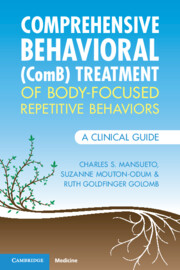Book contents
- Comprehensive Behavioral (ComB) Treatment of Body-Focused Repetitive Behaviors
- Comprehensive Behavioral (ComB) Treatment of Body-Focused Repetitive Behaviors
- Copyright page
- Contents
- Foreword
- Acknowledgments
- Introduction
- Chapter 1 Overview of Body-Focused Repetitive Behaviors
- Chapter 2 Clinical Presentation of Body-Focused Repetitive Behaviors
- Chapter 3 Overview of Body-Focused Repetitive Behaviors Treatment
- Chapter 4 Getting Started with Comprehensive Behavioral Treatment
- Chapter 5 Gathering Information
- Chapter 6 Implementing Appropriate Interventions
- Chapter 7 Implementation of Specific Interventions
- Chapter 8 Self-Care Strategies for Client Support during Treatment and after Termination
- Chapter 9 Working with Children and Families
- Chapter 10 Troubleshooting Difficult Issues and Moving Forward with Treatment
- Appendix
- References
- Index
Chapter 2 - Clinical Presentation of Body-Focused Repetitive Behaviors
A Brief Introduction to the Comprehensive Behavioral Model
Published online by Cambridge University Press: 07 September 2023
- Comprehensive Behavioral (ComB) Treatment of Body-Focused Repetitive Behaviors
- Comprehensive Behavioral (ComB) Treatment of Body-Focused Repetitive Behaviors
- Copyright page
- Contents
- Foreword
- Acknowledgments
- Introduction
- Chapter 1 Overview of Body-Focused Repetitive Behaviors
- Chapter 2 Clinical Presentation of Body-Focused Repetitive Behaviors
- Chapter 3 Overview of Body-Focused Repetitive Behaviors Treatment
- Chapter 4 Getting Started with Comprehensive Behavioral Treatment
- Chapter 5 Gathering Information
- Chapter 6 Implementing Appropriate Interventions
- Chapter 7 Implementation of Specific Interventions
- Chapter 8 Self-Care Strategies for Client Support during Treatment and after Termination
- Chapter 9 Working with Children and Families
- Chapter 10 Troubleshooting Difficult Issues and Moving Forward with Treatment
- Appendix
- References
- Index
Summary
The Comprehensive Behavioral (ComB) conceptual model is introduced in this chapter. Here, three phases of BFRB behaviors: Preparatory behaviors, pulling or picking behaviors, and post-removal behaviors are detailed. The functional assessment of individual BFRB practices is emphasized, in which antecedent variables, both internal and external to the individual are described, as are possible consequences of pulling, both of which impact on the performance and perpetuation of BFRB activity. Identification and description of antecedent and consequential variables (sensory, cognitive, affective, and motor) emphasize the complexity and heterogeneity of internally experienced BFRB experiences that impact on BFRB persistence. The ComB conceptual framework described here sets the stage for ComB-based clinical interventions introduced in later chapters.
Keywords
- Type
- Chapter
- Information
- Comprehensive Behavioral (ComB) Treatment of Body-Focused Repetitive BehaviorsA Clinical Guide, pp. 17 - 27Publisher: Cambridge University PressPrint publication year: 2023

